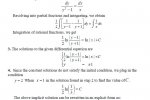You are using an out of date browser. It may not display this or other websites correctly.
You should upgrade or use an alternative browser.
You should upgrade or use an alternative browser.
Implicit to Explicit
- Thread starter Evil
- Start date
D
Deleted member 4993
Guest
Hi,
I am new here and I have the course "Differential Equations." Please explain me what is the easiest way to convert implicit functions into explicit functions ?
Thanks.
Some implicit functions cannot be reduced to explicit functions - so there is no general (easy) way.
jonah2.0
Full Member
- Joined
- Apr 29, 2014
- Messages
- 534
WARNING: Beer soaked rambling/opinion/observation/reckoning ahead. Read at your own risk. Would be readers can take it seriously or take it with a grain of salt. In no event shall the wandering math knight-errant Sir jonah in his inebriated state (usually in his dead tired but mentally revived inebriated state) be liable to anyone for special, collateral, incidental, or consequential damages in connection with or arising out of the use of his "enhanced" beer (and tequila/absinthe) powered views.
Evil, I love your name.
Evil, I love your name.
oh! but today's lecture I gone through 1/2 ln [1/3] = C is converted into Y = 3 + x^2 / 3 - x^2
But did not get how it is, can you plz explain ?
I'm not sure what you mean by this problem. Can you please give more details?
As far as converting an implicit function to an explicit function and what Subhotosh Khan meant is that some functions can not be transformed from implicit functions to explicit functions. For example, look at the page
http://en.wikipedia.org/wiki/Implicit_function
where they talk about implicit functions and give the example of an implicit function which has no explicit representation:
y5 - y = x
where y is considered as a function of x.
Of course other functions do have an explicit representation such as the implicit function
y3 = x
and its explicit counterpart
y = x1/3
and others have dual (or more representations). The classic example of the dual representation is the implicit equation of a circle
x2 + y2 = 1
and its two explicit counterparts
y = \(\displaystyle \sqrt{1-x^2}\)
and
y = \(\displaystyle -\sqrt{1-x^2}\)
- Joined
- Feb 4, 2004
- Messages
- 16,583
Since the log equation, containing no variables, and the second equation, containing two variables, are entirely different, there is no way to "convert" the first into the second, at least not without a whole lot of other information.oh! but today's lecture I gone through 1/2 ln [1/3] = C is converted into Y = 3 + x^2 / 3 - x^2
But did not get how it is, can you plz explain ?
Please reply with the complete context and all of the intermediate steps from class. Thank you!
I have uploaded two files, you can see what is happening, plz reply me soon
Lets start with the integration of the partial fractions where we have
\(\displaystyle \frac{1}{2}ln(\frac{|y-1|}{|y+1|}) = ln(|x|)\, +\, C\)
In order to find out what the constant C is, we use the initial condition y=2 when x=1. Substituting those two values into the above equation we get
\(\displaystyle \frac{1}{2}ln(\frac{|2-1|}{|2+1|}) = ln(|1|)\, +\, C\)
or
\(\displaystyle \frac{1}{2}ln(\frac{1}{3}) = C\)
and we can write the solution as
\(\displaystyle \frac{1}{2}ln(\frac{|y-1|}{|y+1|}) = ln(|x|)\, +\, \frac{1}{2}ln(\frac{1}{3})\)
or
\(\displaystyle ln(\frac{|y-1|}{|y+1|}) = 2\, ln(|x|)\, +\, ln(\frac{1}{3})\)
Using a couple of the rules for logarithms this gives
\(\displaystyle ln(\frac{|y-1|}{|y+1|}) = ln(\frac{1}{3}x^2)\)
Lets look at the solution:
First, suppose either y>1 OR y<-1. Then we can remove the absolution value signs since both y-1 and y+1 are positive and the ratio is positive OR both y-1 and y+1 are negative and the ratio is positive. So, again using one of the rules for logarithms, we have
\(\displaystyle \frac{y-1}{y+1} = \frac{1}{3}x^2\)
or, solving for y
\(\displaystyle y = \frac{1\, +\, \frac{1}{3}x^2}{1\, -\, \frac{1}{3}x^2}\, =\, \frac{3\, +\, x^2}{3\, -\, x^2}\)
Next, suppose -1<y<1. Then y-1 and y+1 are of opposite signs and we will need to reverse the sign of one of the expression when removing the absolute value sign. Thus, again using one of the rules for logarithms, we have
\(\displaystyle \frac{1-y}{y+1} = \frac{1}{3}x^2\)
or, solving for y
\(\displaystyle y = \frac{1\, -\, \frac{1}{3}x^2}{1\, +\, \frac{1}{3}x^2}\, =\, \frac{3\, -\, x^2}{3\, +\, x^2}\)
D
Deleted member 4993
Guest
Can you please explain briefly, how logarithm is applied, because I am learning Math after a few years.
Thanks.
For that, you need a face-to-face tutor.
For that, you need a face-to-face tutor.
Now problem is solved, got it, how logrithem is used.

